Equine coat color

Horses exhibit a diverse array of coat colors and distinctive markings. A specialized vocabulary has evolved to describe them.
While most horses remain the same color throughout life, a few, over the course of several years, will develop a different coat color from that with which they were born. Most white markings are present at birth, and the underlying skin color of a horse does not change, absent disease.
The basic outline of equine coat color genetics has largely been resolved, and DNA tests to determine the likelihood that a horse will have offspring of a given color have been developed for some colors. Discussion, research, and even controversy continues about some of the details, particularly those surrounding spotting patterns, color sub-shades such as "sooty" or "flaxen", and markings.
Basic coat colors
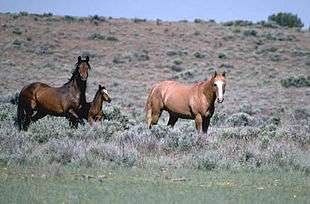
Genetically, all horses start out as either chestnut, called "red" by geneticists, represented by the absence of the extension gene ("e"); or black based on the presence of the extension gene ("E"). Therefore, red ("ee") and black ("EE" or "Ee") are the two base colors.[1][2] The Bay color is expressed when a common genetic modifier, the Agouti gene, works on black. The vast range of all other coat colors are created by additional genes' action upon one of these three coat colors.
Statistically, the most commonly seen horse color phenotypes are identified by the following terms:
- Bay: Body color ranges from a light reddish-brown to very dark brown with "black points". (Points refer to the mane, tail, and lower legs.) The main color variations are:
- Dark bay: very dark red or brown hair, difficult to distinguish from seal brown. Sometimes also called "black bay", "mahogany bay", or "brown".
- Blood bay: bright red hair; often considered simply "bay".
- Brown: The word "brown" is used by some breed registries to describe dark bays. There is a distinct allele that darkens a bay coat to seal brown (At), but it is not the cause of all forms of dark bay. Informally, "brown" is applied to many distinct coat colors. Most often, horses described by casual observers as "brown" are actually bay or chestnut. In the absence of DNA testing, chestnut and bay can be distinguished from each other by looking at the mane, tail and legs for the presence of black points.
- Chestnut: A reddish body color with no black. Mane and tail are the same shade or lighter than the body coat. The main color variations are:

- Gray: A horse with black skin but white or mixed dark and white hairs. Gray horses can be born any color, and lighten as they age. Most will eventually gray out to either a complete white or to a "fleabitten" coat, which retains speckles of the horses original colour. Most "white" horses are actually grays with a fully white hair coat. A gray horse is distinguished from a white horse by dark skin, particularly noticeable around the eyes, muzzle, flanks, and other areas of thin or no hair. Variations of gray that a horse may exhibit over its lifetime include:
- Salt and Pepper or "steel" gray: Usually a younger horse, an animal with white and dark hairs evenly intermixed over most of the body.
- Dapple gray: a dark-colored horse with lighter rings of graying hairs, called dapples, scattered throughout.
- Fleabitten gray: an otherwise fully white-haired horse that develops red hairs flecked throughout the coat.
- Rose gray: a gray horse with a reddish or pinkish tinge to its coat. This color occurs with a horse born bay or chestnut while the young horse is "graying out".
Other coat colors
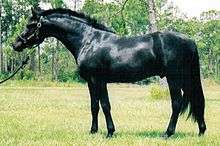
- Black: Black is relatively uncommon, though it is not "rare". There are two types of black, fading black and non-fading black. Most black horses will fade to a brownish color if the horse is exposed to sunlight regularly. Non-fading black is a blue-black shade that does not fade in the sun. Genetically, the two cannot yet be differentiated, and some claim the difference occurs due to management rather than genetics, though this claim is hotly disputed. Most black foals are usually born a mousy grey or dun color. As their foal coat begins to shed out, their black color will show through, though in some breeds black foals are born jet black. For a horse to be considered black, it must be completely black except for white markings. A sun-bleached black horse is still black, even though it may appear to be a dark bay or brown. A visible difference between a true black and a dark chestnut or bay is seen in the fine hairs around the eyes and muzzle; on a true black these hairs are black, even if the horse is sun-bleached, on other colors, they will be lighter.
- Brindle: One of the rarest colors in horses, possibly linked to chimerism. Characteristics are any color with "zebra-like" stripes, but most common is a brown horse with faint yellowish markings. A heritable brindle pattern in a family of American Quarter Horses that has been named Brindle1 was identified and announced in late 2016.
- Buckskin: A bay horse with one copy of the cream gene, a dilution gene that "dilutes" or fades the coat color to a yellow, cream, or gold while keeping the black points (mane, tail, legs).
- Champagne: Produced by a different dilution gene than the cream gene. It lightens both skin and hair, but creates a metallic gold coat color with mottled skin and light colored eyes. Champagne horses are often confused with palomino, cremello, dun, or buckskins.
- Cream dilution, an incomplete dominant gene that produces a partially diluted coat color with one copy of the allele and a full dilution with two copies. Colors produced include Palomino, Buckskin, Perlino, Cremello and Smoky Cream or Smoky black.
- Cremello: A horse with a chestnut base coat and two cream genes that wash out almost all color until the horse is a pale cream or light tan color. Often called "white", they are not truly white horses, and they do not carry the white (W) gene. A cremello usually has blue eyes.
- Dun: Yellowish or tan coat with primitive markings, sometimes called "dun factors": a darker-colored mane and tail, a dorsal stripe along the back and occasionally faint horizontal zebra stripings on the upper legs and a possible transverse stripe across the withers. There are several variations of dun:
- Grullo, Grulla, or Blue Dun: A horse with a black base color and the dun gene. Coat is solid "mouse-colored" gray or silver (can also be almost brownish-gray) with black or dark gray primitive markings.
- Red dun: A chestnut base coat with dun factors. Coat is usually pale yellow or tan with chestnut (red) primitive markings.
- "Bay dun" or "Zebra dun" are terms sometimes used to describe the classic dun color of yellow or tan with black primitive markings, used when necessary to distinguish it from red duns or grullos.
- "Buckskin dun" or "Yellow dun" describes a dun that also carries the cream gene dilution and has a coat of pale gold with black mane, tail, legs and primitive markings.
- Leopard: There are a group of coat patterns caused by the leopard gene complex. It should be noted that not every horse with leopard genetics will exhibit hair coat spotting. However, even solid individuals will exhibit secondary characteristics such as vertically striped hooves and mottled skin around the eyes, lips, and genitalia, plus a white sclera of the eye. Several breeds of horse can boast leopard-spotted (a term used collectively for all patterns) individuals including the Knabstrupper, Noriker, and the Appaloosa. There are several distinct leopard patterns:
- blanket: white over the hip that may extend from the tail to the base of the neck. The spots inside the blanket (if present) are the same color as the horse's base coat.
- varnish roan: a mix of body and white hairs that extends over the entire body—no relation to true roan
- snowflake: white spots on a dark body. Typically the white spots increase in number and size as the horse ages.
- leopard: dark spots of varying sizes over a white body.
- few spot leopard: a nearly white horse from birth that retains color just above the hooves, the knees, "armpits", mane and tail, wind pipe, and face
- frost: similar to varnish but the white hairs are limited to the back, loins, and neck.
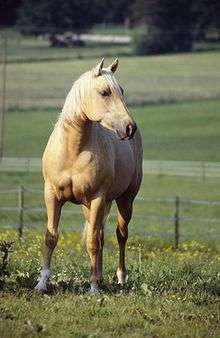
- Palomino: chestnut horse that has one cream dilution gene that turns the horse to a golden, yellow, or tan shade with a flaxen or white mane and tail. Often cited as being a color "within three shades of a newly minted gold coin", palominos range in shades from extremely light, almost cremello, to deep chocolate, but always with a white or flaxen mane and tail.
- Pearl: Also called the "barlink factor", A dilution gene that when homozygous, lightens red coats to a uniform apricot-like color, often also resulting in horses with blue eyes. When combined with cream dilution, may produce horses that appear to be cremello or perlino.
- Perlino: similar to a cremello, but is genetically a bay base coat with two dilute genes. Eyes are blue. Mane, tail and points are not black, but are usually darker than the body coat, generally a reddish or rust color, not to be confused with a red dun.
- Pinto: a multi-colored horse with large patches of brown, white, and/or black and white. Often confused with Paint, which is a narrower term referring to a specific breed of mostly pinto horses with known Quarter Horse and/or Thoroughbred bloodlines.
- Variations of pinto color patterning include:
- Piebald: a black and white spotting pattern (term more commonly used in the UK than the USA)
- Skewbald: a spotting pattern of white and any other color other than black, or a spotting pattern of white and two other colors, which may include black. (term more commonly used in the UK than the USA).
- Overo: Describes a group of spotting patterns genetically distinct from one another, characterized by sharp, irregular markings with a horizontal orientation, usually more dark than white. In some cases, the face is usually white, often with blue eyes. The white rarely crosses the back, and the lower legs are normally dark. Variations include "Frame Overo" and "Splashed white". Sometimes Sabino (below) is also classified in the overo family.
- Sabino: Often confused with roan or rabicano, a slight spotting pattern characterized by high white on legs, belly spots, white markings on the face extending past the eyes and/or patches of roaning patterns standing alone or on the edges of white markings
- Tobiano: Spotting pattern characterized by rounded markings with white legs and white across the back between the withers and the dock of the tail, usually arranged in a roughly vertical pattern and more white than dark, with the head usually dark and with markings like that of a normal horse. i.e. star, snip, strip, or blaze.
- Tovero: spotting pattern that is a mix of tobiano and overo coloration, such as blue eyes on a dark head. May also refer to horses with Tobiano coloring that carry a recessive overo gene.
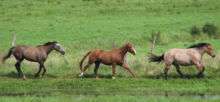
- Rabicano: A roan-like effect that is caused by a genetic modifier that creates a mealy, splotchy, or roaning pattern on only part of the body, usually limited to the underside, flanks, legs, and tail head areas. Unlike a true roan, much of the body will not have white hairs intermingled with solid ones, nor are the legs or head significantly darker than the rest of the horse.
- Roan: a color pattern that causes white hairs to be evenly intermixed within the horse's body color. Roans are distinguishable from greys because roans typically do not change color in their lifetimes, unlike gray that gradually gets lighter as a horse ages. Roans also have heads that are either solid-colored or much darker than their body hair, and do not lighten. Variations of roan include:
- Red Roan: A chestnut base coat with roaning pattern with the mane and tail being the same red as the body. Red roans is sometimes called Strawberry Roan, and the term Red Roan is occasionally used to describe a Bay Roan.[3]
- Bay Roan: A Bay base coat with roaning pattern (the mane and tail of the Bay Roan will be Black). Bay roans are sometimes also called Red Roans.[3]
- Blue Roan: A black with roaning pattern, not to be confused with a gray or a blue dun/grullo. A roan tends to have a darker head, while grays not only lighten with age, but their heads tend to lighten before the rest of their bodies. A blue roan has mixed-color hairs, a blue dun will usually be a solid color and have dun striping.
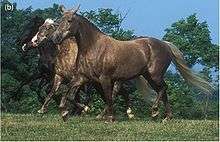
- Silver dapple: Caused by a dilution gene that only acts upon black hair pigment, it lightens black body hair to a chocolate brown and the mane and tail to silver. The gene may be carried but will not be visible on horses with a red base coat. Silver dapple horses may also be called Chocolate, Flax, or Taffy.
- Smoky black: A horse which visually appears to be either a black with a mildly bleached-out coat or a dull dark bay, but actually has a black base coat and one copy of the cream gene.
- Smoky Cream: Virtually indistinguishable from a cremello or perlino without DNA testing, a horse with a black base coat and two copies of the cream gene.
- White : One of the rarest colors, a white horse has white hair and fully or largely unpigmented (pink) skin. These horses are born white, with blue or brown eyes, and remain white for life. The vast majority of so-called "white" horses are actually grays with a fully white hair coat. A truly white horse that lives to adulthood occurs one of two ways: either by inheriting one copy of a dominant white ("W") gene, of which several have been identified, or is a particular type of sabino that is homozygous for the "SB-1" gene. However, a foal with the genetic disease known as lethal white syndrome dies shortly after birth.[4] There are no "albinos" in the horse world. Albino, defined as animals with a white coat with pink skin and reddish eyes, is created by genetic mechanisms that do not exist in horses.[5] In some cases, homozygous dominant white is thought to be an embryonic lethal, though this has not been established for all white horses.
Other color modifiers
- Sooty is a genetic modifier that causes dark hairs to be dispersed within the coat, darkening the whole coat.
- Pangaré is a modifier that is the opposite of sooty, it causes individual hairs to lighten, causing lightened areas on the muzzle, flank and belly of a horse.
- "Flaxen" used only to describe the lightened mane and tail of a chestnut, has been proposed as a genetic modifier, particularly when it appears to be a trait of certain breeds. However, the genetic mechanism of this process has yet to be identified.
- Mushroom dilutes red-based horses to a pale tan color.
Markings and other unique identifiers

White markings are present at birth and unique to each horse, making them useful in identifying individual animals. Markings usually have pink skin underneath them, though some faint markings may not, and white hairs may extend past the area of underlying pink skin. Though markings that overlie dark skin may appear to change, the underlying skin color and hair growing from pink skin will not. Horses may also be uniquely identified by an unusual eye color, whorls, brands and chestnuts.
Color breeds
Registries have opened that accept horses (and sometimes ponies and mules) of almost any breed or type, with color either the only requirement for registration or the primary criterion. These are called "color breeds". Unlike "true" horse breeds, there are few if any unique physical characteristics required, nor is the stud book limited to only certain breeds or offspring of previously registered horses. As a general rule, the color also does not always breed on (in some cases, due to genetic improbability), and offspring without the stated color are usually not eligible for recording with the color breed registry. The best-known color breed registries are for buckskins, palominos, and pintos.
Some "true" breeds also have color that usually breeds on as well as distinctive physical characteristics and a limited stud book. These horses are true breeds that are said to have a "color preference". They are not color breeds, and include the Friesian horse (must be uniformly black for mainstream registration), the Appaloosa (Leopard or other Leopard complex patterns) and the American Paint Horse. In some breeds, though not all, offspring of animals registered in these stud books can also be registered, sometimes with restrictions, even if they do not have the desired color.
See also
Notes
- ↑ http://www.thehorse.com/articles/31651/equine-coat-color-genetics-101
- ↑ Marklund, L.; M. Johansson Moller; K. Sandberg; L. Andersson (1996). "A missense mutation in the gene for melanocyte-stimulating hormone receptor (MC1R) is associated with the chestnut coat color in horses". Mammalian Genome. 7 (12): 895–899. PMID 8995760. doi:10.1007/s003359900264.
- 1 2 "General Glossary". American Quarter Horse Association. Archived from the original on August 24, 2010. Retrieved August 25, 2012.
- ↑ Metallinos, DL; Bowling AT; Rine J (June 1998). "A missense mutation in the endothelin-B receptor gene is associated with Lethal White Foal Syndrome: an equine version of Hirschsprung Disease". Mammalian Genome. New York: Springer New York. 9 (6): 426–31. PMID 9585428. doi:10.1007/s003359900790. Retrieved 2008-09-04.
- ↑ Castle, William E. (1948). "The Abc of Color Inheritance in Horses". Genetics. 33 (1): 22–35. PMC 1209395
 . PMID 17247268.
. PMID 17247268. No true albino mutation of the color gene is known among horses, though several varieties of white horse are popularly known as albinos.
References
- "Equine Coat Color Tests". Veterinary Genetics Lab, University of California, Davis. Retrieved August 25, 2012.
- "Introduction to Coat Color Genetics". Veterinary Genetics Lab, University of California, Davis. Retrieved August 25, 2012.
- "Equine Services". Animal Genetics Inc. Retrieved August 25, 2012. Performs new gray gene testing for horses.
External links
| Wikimedia Commons has media related to Horse coat colors. |